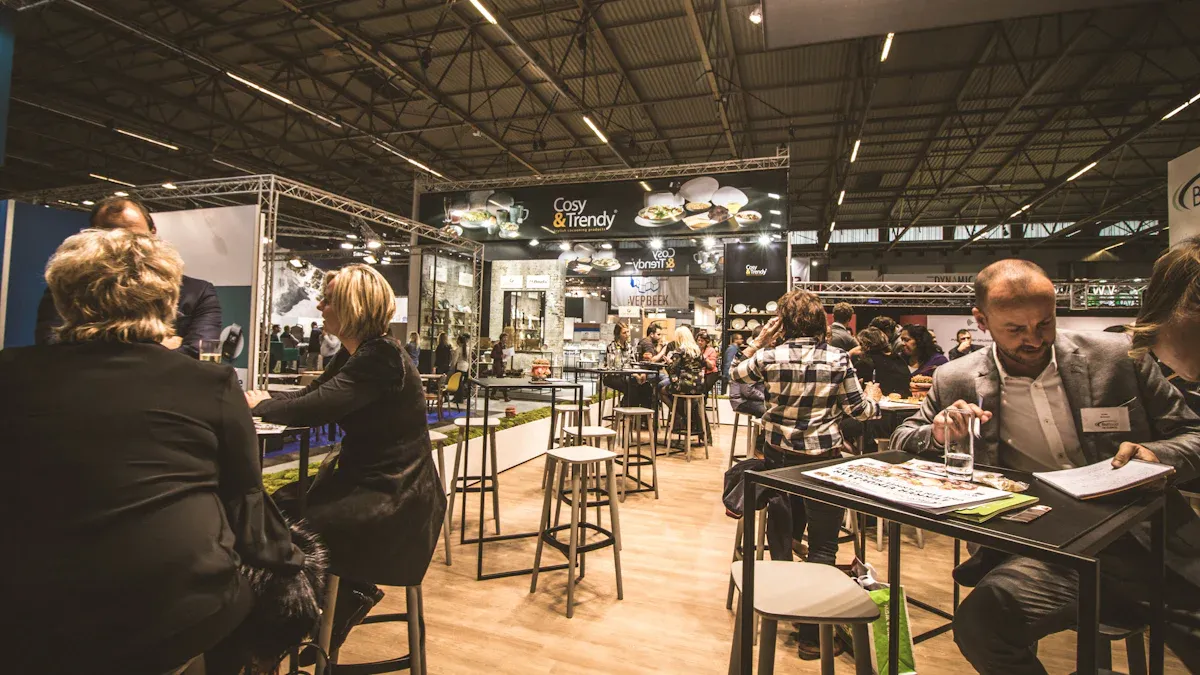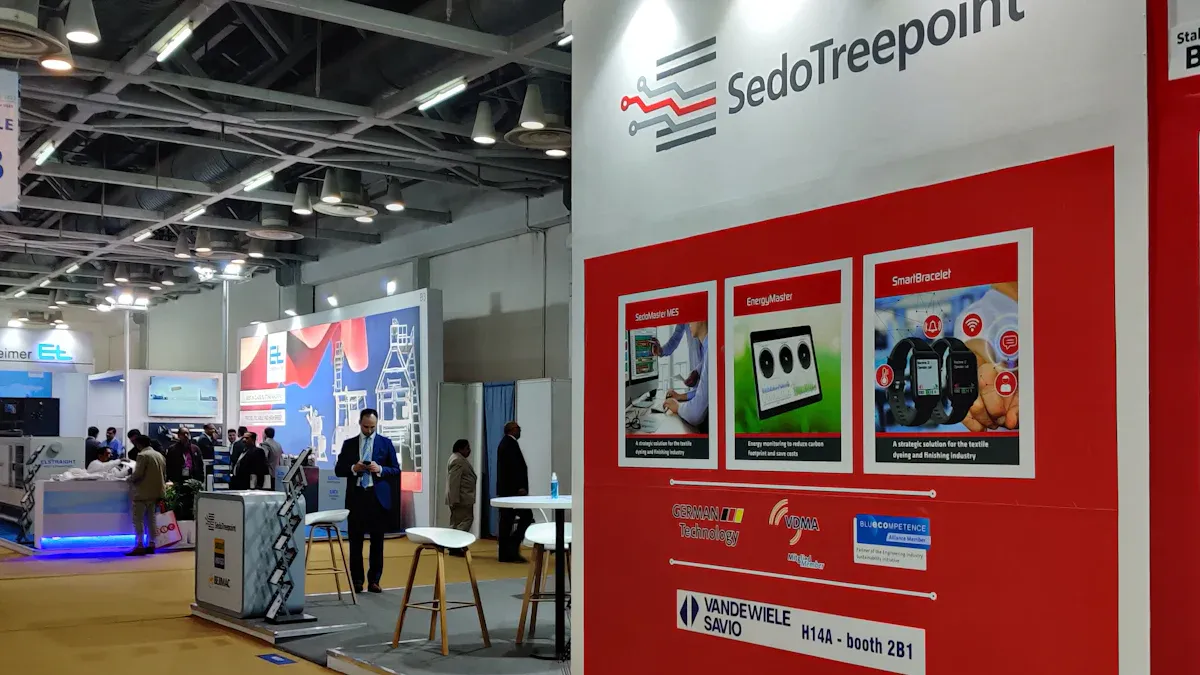
If you want to create a successful exhibition stand design, start by setting clear goals. Think about what you want to achieve and who you want to reach. Make your objectives specific, measurable, and realistic. Give yourself deadlines, so you stay on track. When you understand your audience and plan with purpose, you set the stage for a great exhibition. Take a moment to consider your goals and the resources you have before you dive in.
Key Takeaways
Set clear goals for your exhibition stand. Define what you want to achieve, like generating leads or increasing brand awareness.
Understand your audience. Research their demographics and interests to create a stand that speaks directly to them.
Establish a budget before designing your stand. This helps you make informed choices and avoid unexpected costs.
Choose the right type of stand. Consider options like modular, custom, or portable stands based on your goals and budget.
Plan your layout carefully. Create an inviting space that guides visitors and encourages interaction.
Objectives & Audience
Define Goals
Before you start designing your exhibition stand, you need to know what you want to achieve. Clear goals help you stay focused and measure your success. Many businesses set objectives like raising their brand profile, generating new leads, or increasing social media reach. Some aim for awards or want to draw big crowds. Here are some common goals you might consider:
Value for money—do you want to boost your brand or get more leads?
Generate new leads—think of ways to attract potential customers.
Quality of conversation—focus on having great talks at your stand.
Awards and recognition—try to win industry awards.
Volume of visitors—create offers that bring people in.
You can also set goals like launching a new product, engaging with current customers, or doing market research. Make your goals specific and measurable. For example, you might want to collect 50 new leads or make one sale during the exhibition. Use a table to help you plan:
Goal Type | Example Goal | Measurement Metric |
|---|---|---|
Sales | Achieve one sale | Number of sales made |
Lead Generation | Collect 50 leads | Number of leads collected |
ROI Measurement | Track event success | ROI metrics |
Know Your Audience
Understanding your audience makes your exhibition stand more effective. Start by learning about their age, job, and interests. This helps you design a stand that speaks to them. You can use these steps:
Identify your audience’s demographics.
Find out what they like and what problems they want to solve.
Design your stand to match their needs.
You can also segment your audience into groups based on their roles or industry. Create messages that connect with their goals. Before the exhibition, reach out to let them know you’ll be there. During the event, make your booth inviting and talk to visitors in a way that feels personal. When you know your audience, you can create an exhibition experience they will remember.
Budget & Stand Type
Set Budget
Before you start building your exhibition stand, you need to know how much you can spend. Setting a clear budget helps you make smart choices and avoid surprises. Costs can change a lot depending on the type of stand you want. Here’s a quick look at average price ranges for different exhibition stands:
Type of Stand | Price Range |
|---|---|
Fully designed stands | £1,700 to £20,000 |
Shell scheme stands | from £1,700 |
Modular stands | £3,000 to £30,000+ |
Think about what you want to achieve at the exhibition. Do you want a simple setup, or do you need something that stands out? Your budget will guide your decisions. Remember to include extra costs like graphics, lighting, and furniture. If you plan ahead, you can get the most value from your exhibition experience.
Tip: Always leave a little extra in your budget for last-minute changes or upgrades.
Choose Stand Type
Now it’s time to pick the right stand for your exhibition. Each type has its own benefits and costs. Here’s a table to help you compare:
Stand Type | Cost Effectiveness | Reusability | Branding Opportunities |
|---|---|---|---|
Modulaire | High | High | Moderate |
Custom | Low | Low | High |
Portable | Moderate | Moderate | Low |
Modular stands work well if you go to many exhibitions. You can use them again and again, and they save money over time.
Custom stands look unique and show off your brand, but they cost more and you usually can’t reuse them.
Portable displays are easy to move and set up. They fit smaller budgets and work for businesses that attend lots of exhibitions.
When you choose your stand, think about your goals, how often you exhibit, and how much you want to spend. The right choice will help you make a big impact at your next exhibition.
Exhibition Stand Design Basics

Concept & Branding
You want your exhibition stand design to stand out and tell your story. Start the design phase by writing a detailed brief. This brief should explain your business, your goals, and who you want to reach at the exhibition. When you know what you want, you can make choices that fit your brand and connect with your audience.
Branding is more than just a logo. It’s about creating an experience that people remember. Use bold graphics, high-resolution images, and clear signage to show off your brand. Consistency is key—make sure your colors, fonts, and messages match across every part of your trade show booth. When you do this, visitors will recognize your brand right away.
Tip: Think about how you want people to feel when they visit your stand. Do you want them to feel excited, curious, or inspired? Use colors, lighting, and music to set the mood.
Here are some ways to boost your branding at an exhibition:
Create interactive experiences, like hands-on demos or games, that match your brand’s style.
Use digital tools, such as LED displays or augmented reality, to make your trade show booth more memorable.
Give away branded items that visitors can take home. These small gifts help people remember your company long after the event.
Train your team to act as brand ambassadors. Friendly, knowledgeable staff can make a big difference.
A strong exhibition stand design uses storytelling. Share your brand’s story through visuals and activities. When you combine digital innovation with physical displays, you create a dynamic environment that grabs attention. This approach helps people remember your brand and can even turn visitors into fans.
Layout & Caractéristiques
The layout of your exhibition stand design shapes how people move and interact with your space. A smart layout guides visitors through different zones, making their experience smooth and enjoyable. Start by planning open spaces that feel welcoming. Avoid clutter, so people don’t feel crowded.
Here are some practical tips for your trade show booth layout:
Place your most important products or messages at eye level.
Use lighting to highlight key areas and create a warm atmosphere.
Add interactive features, like touch screens or product demos, to keep visitors engaged.
Set up comfortable seating areas where people can relax and chat with your team.
Make sure there’s enough storage for your marketing materials and giveaways.
A good exhibition stand design also considers the flow of foot traffic. You want visitors to enter, explore, and stay longer. Use clear pathways and signs to guide them. If you can, choose a booth location near busy areas of the exhibition hall.
Here’s a table of essential elements for an effective exhibition stand design:
Essential Element | Description |
|---|---|
Structural Soundness | Make sure your stand is safe and follows all rules. |
Ease of Assembly | Design your booth so it’s quick to set up and take down. |
Storage & Accessibility | Keep your space tidy and make it easy to reach what you need. |
Lighting | Use lights to draw attention and create a welcoming feel. |
Graphics & Branding | Use bold visuals to reinforce your brand and attract visitors. |
Layout & Visitor Flow | Guide people through your booth for a better experience. |
Sustainable Materials | Choose eco-friendly options to show you care about the environment. |
You can also use technology to make your trade show booth more exciting. Try adding VR or AR experiences, or set up games and quizzes that get people involved. These features help you stand out and make your exhibition memorable.
Note: A well-trained team is just as important as your booth design. Friendly staff who know your products can answer questions and make visitors feel welcome.
If you want to attract more people, think about offering giveaways or running contests. These activities draw crowds and give you a chance to collect leads. Always include a clear call to action, so visitors know what to do next—like signing up for a newsletter or booking a meeting.
When you focus on both branding and layout, your exhibition stand design will not only look great but also work hard for your business. You’ll create a space that draws people in, keeps them engaged, and leaves a lasting impression.
Materials & Logistics

Select Materials
Choosing the right materials for your exhibition stand makes a big difference. You want your booth to look great, but you also need it to be practical. Many people use fabric graphics because they are lightweight and easy to carry. You can swap them out for different events, and they give your stand a clean, modern look. Just remember, fabric can wrinkle and may not last as long as harder materials.
Here’s a quick look at popular materials and their uses:
Material Type | Advantages | Common Uses |
|---|---|---|
Wood | Warm, high-end, creative freedom | Custom-built stands |
Aluminium | Léger, durable, customizable | Framing structures |
PVC | Budget-friendly, light, signage | Signage and panels |
Tissu | Portable, vibrant printing | Backdrops, banners |
Plexiglass | Modern, transparent, customizable | Display cases, partitions |
Cardboard | Eco-friendly, cost-effective | One-time, creative displays |
Sustainability is now a big trend in the exhibition world. Eco-friendly materials and energy-saving tech help your brand look responsible and can save money over time.
Plan Manufacturing
Once you pick your materials, it’s time to plan how your exhibition stand will be built. Start by finalizing your design and setting a clear timeline. Usually, designing and getting started takes 1 to 2 weeks. Finding materials and finishing the design can take another 2 to 4 weeks. Building the stand itself might take 1 to 3 weeks, depending on how custom or complex your exhibition booth is.
Keep quality in mind at every step. A well-made stand will last longer and look better at each exhibition. Modular designs can help you save money and keep your branding consistent across different events.
Organize Installation
Getting your exhibition stand set up at the venue can be tricky. You might face tight deadlines, heavy or large exhibits, or even last-minute changes. Good planning helps you avoid stress. Make a clear floor plan and share it with your team. Assign tasks based on everyone’s strengths and always put safety first.
Tip: Take photos and notes during installation. This helps you remember what worked and makes the next exhibition even smoother.
If you plan ahead and stay flexible, you’ll handle any surprises and make your exhibition a success.
Finalize & Revoir
Visualize Design
Before you start building an exhibition stand, you need to see how your ideas look in real life. Visualization tools help you preview your stand before anything gets built. Many online platforms let you access a wide range of templates and custom options right from your browser. You can pick a design, change it to fit your needs, and even get a personal consultation for special requests. These tools also create 3D images that are perfect for showing your team or decision-makers.
Fonctionnalité | Description |
|---|---|
Easy access | Use in your browser, no downloads needed. |
Wide range of options | Choose from many stand designs and flexible setups. |
Quick start with templates | Start with ready-made designs and make them your own. |
Custom design options | Get help for unique or special requests. |
Professional presentations | Use 3D views for team meetings or client pitches. |
3D rendering technology makes your exhibition stand construction smoother. You can spot problems early, adjust layouts, and make sure your booth matches your brand. These visuals also help you plan for visitor flow and create marketing materials.
See your booth before it’s built.
Make changes easily.
Plan for better visitor experiences.
Use images for promotions.
Team Feedback
Getting feedback from your team is key. When everyone shares ideas, your exhibition stand gets better. Team input helps you match the design to your goals and fix any issues before the event. You can talk through the design, ask questions, and make changes together. This back-and-forth makes your booth more functional and attractive.
Team feedback helps you meet your goals.
You can improve both the look and use of your stand.
Clear communication leads to a better final product.
Tip: Hold a review meeting with your team and ask for honest opinions. Sometimes the best ideas come from unexpected places!
Prepare for Event
Now you’re almost ready for the big day. Good preparation makes your exhibition a success. Start by checking your goals and making sure your booth fits your audience. Book your spot early and set a budget. Create a design brief and promote your booth before the event. Plan your logistics, train your team, and get ready to engage visitors.
Learn about your audience.
Book your space and plan your budget.
Write a design brief.
Tell people you’ll be at the event.
Arrange shipping and setup.
Train your team.
Get ready to welcome visitors.
Track your results after the event.
Sometimes, last-minute problems pop up. You might need to change your design, fix equipment, or deal with shipping delays. Keep backup supplies and stay flexible. Good planning and teamwork help you handle surprises and make your exhibition stand out.
You can design a winning exhibition stand by following a clear step-by-step process:
Discover your goals and audience.
Develop creative ideas with your team.
Bring your vision to life and deliver on time.
Teamwork makes each part stronger, just like an orchestra. Careful planning helps you reach your goals and keeps things running smoothly. For the best results, train your staff, use interactive displays, and track your leads. These steps help you stand out and make a real impact at your next event.
FAQ
What makes a great exhibition stand?
A great exhibition stand grabs attention fast. You want bold colors, clear branding, and an open layout. Make sure your exhibition stand feels welcoming. Add interactive features or demos. People remember exhibition stands that offer something fun or useful.
How do I choose between modular and bespoke exhibition stands?
Think about your goals and budget. Modular exhibition stands work well for many trade shows. You can reuse them. Bespoke exhibition stands give you a unique look. If you want your exhibition stand to stand out, go bespoke. For flexibility, modular is best.
Can I use my exhibition stand at different trade shows?
Yes! Many exhibition stands are designed for easy setup and transport. Modular exhibition stands work best for this. You can change the layout or graphics for each exhibition. If you pick bespoke exhibition stands, check if they can be reused before you buy.
What should I include in my exhibition stand for trade shows?
You need clear signs, affichages de produits, and a place to talk with visitors. Add storage for your stuff. Use lights to highlight your exhibition stand. Giveaways or games help draw people in. Always plan your exhibition stand to match your goals for the exhibition.
Tip: Walk around the exhibition before the event starts. Look at other exhibition stands for ideas. You might spot something you want to try at your next exhibition stand!
